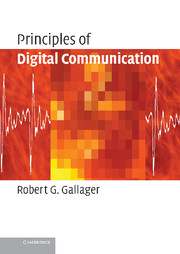Book contents
- Frontmatter
- Contents
- Preface
- Acknowledgements
- 1 Introduction to digital communication
- 2 Coding for discrete sources
- 3 Quantization
- 4 Source and channel waveforms
- 5 Vector spaces and signal space
- 6 Channels, modulation, and demodulation
- 7 Random processes and noise
- 8 Detection, coding, and decoding
- 9 Wireless digital communication
- References
- Index
9 - Wireless digital communication
Published online by Cambridge University Press: 05 June 2012
- Frontmatter
- Contents
- Preface
- Acknowledgements
- 1 Introduction to digital communication
- 2 Coding for discrete sources
- 3 Quantization
- 4 Source and channel waveforms
- 5 Vector spaces and signal space
- 6 Channels, modulation, and demodulation
- 7 Random processes and noise
- 8 Detection, coding, and decoding
- 9 Wireless digital communication
- References
- Index
Summary
Introduction
This chapter provides a brief treatment of wireless digital communication systems. More extensive treatments are found in many texts, particularly Tse and Viswanath (2005) and Goldsmith (2005). As the name suggests, wireless systems operate via transmission through space rather than through a wired connection. This has the advantage of allowing users to make and receive calls almost anywhere, including while in motion. Wireless communication is sometimes called mobile communication, since many of the new technical issues arise from motion of the transmitter or receiver.
There are two major new problems to be addressed in wireless that do not arise with wires. The first is that the communication channel often varies with time. The second is that there is often interference between multiple users. In previous chapters, modulation and coding techniques have been viewed as ways to combat the noise on communication channels. In wireless systems, these techniques must also combat time-variation and interference. This will cause major changes both in the modeling of the channel and the type of modulation and coding.
Wireless communication, despite the hype of the popular press, is a field that has been around for over 100 years, starting around 1897 with Marconi's successful demonstrations of wireless telegraphy. By 1901, radio reception across the Atlantic Ocean had been established, illustrating that rapid progress in technology has also been around for quite a while.
- Type
- Chapter
- Information
- Principles of Digital Communication , pp. 330 - 397Publisher: Cambridge University PressPrint publication year: 2008



